Learning Technologies Group Bundle
Who Does Learning Technologies Group Serve?
The corporate world's rapid digital transformation, amplified by the pandemic, has made learning technologies indispensable. Understanding the Learning Technologies Group SWOT Analysis is crucial to grasp the company's strategic positioning. For companies like Learning Technologies Group (LTG), knowing their customer demographics and target market is not just beneficial; it's fundamental to their success.
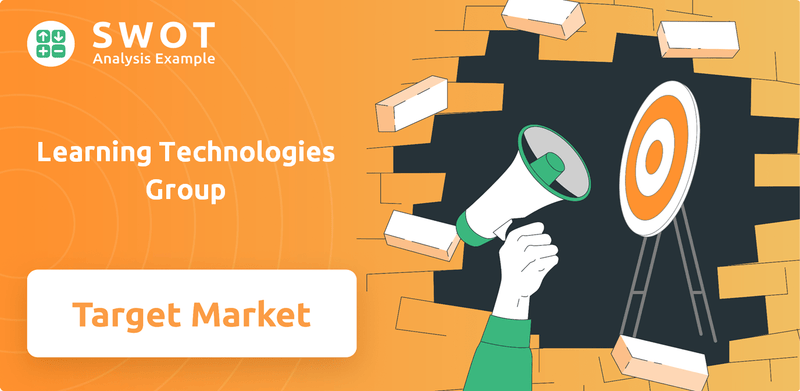
This analysis delves into the specifics of Learning Technologies Group's (LTG) customer base, exploring the evolution of its target market from a broad approach to a more focused, segmented strategy. We'll examine who LTG's customers are, their geographic locations, and the specific needs driving their adoption of digital learning solutions. This deep dive will provide insights into how LTG adapts to the dynamic education technology landscape.
Who Are Learning Technologies Group’s Main Customers?
Understanding the customer demographics and target market of Learning Technologies Group (LTG) is crucial for grasping its business strategy. As a business-to-business (B2B) company, LTG focuses on organizations rather than individual consumers. This focus shapes its approach to audience analysis and product development within the education technology sector.
The primary customer segments for the LTG company are defined by organizational characteristics such as size, industry, and specific learning needs. LTG's solutions are tailored to meet the demands of Human Resources (HR) departments, Learning and Development (L&D) teams, and C-suite executives who are responsible for talent management and organizational performance. This targeting allows LTG to provide effective solutions for various business needs.
LTG's customer base is diverse, spanning multiple sectors. The company serves industries such as healthcare, financial services, retail, technology, and government. This broad appeal demonstrates LTG's capacity to provide valuable services across different sectors that prioritize employee development and compliance training. For more details, you can also check out Revenue Streams & Business Model of Learning Technologies Group.
LTG primarily targets businesses, focusing on mid-market companies and large enterprises. These organizations are spread across various sectors, emphasizing employee development and compliance training.
LTG's solutions are designed for HR departments, L&D teams, and C-suite executives. This focus allows the company to address the specific needs of these key decision-makers within organizations.
The company serves industries like healthcare, financial services, retail, technology, and government. This broad reach shows LTG's ability to provide valuable services across different sectors that prioritize employee development and compliance training.
LTG has expanded its target segments through acquisitions, such as Open LMS. This strategy has helped the company penetrate new markets and cater to more specialized needs, driving revenue growth.
LTG's strategic acquisitions have broadened its reach, with the acquisition of Open LMS expanding into higher education. This expansion has led to varied revenue contributions from different segments. Large enterprises often represent major revenue streams due to the scale of their deployments, while mid-market companies may offer faster growth potential.
- Market Research: LTG continuously conducts market research to understand evolving client needs and industry trends.
- Remote and Blended Learning: The increasing demand for remote and blended learning environments influences LTG's product development and market strategies.
- Revenue Streams: Large enterprises often contribute significantly to revenue due to the scale of their deployments, while mid-market companies offer faster growth potential.
- Strategic Acquisitions: Acquisitions have played a key role in expanding the company's customer base and market reach.
Learning Technologies Group SWOT Analysis
- Complete SWOT Breakdown
- Fully Customizable
- Editable in Excel & Word
- Professional Formatting
- Investor-Ready Format
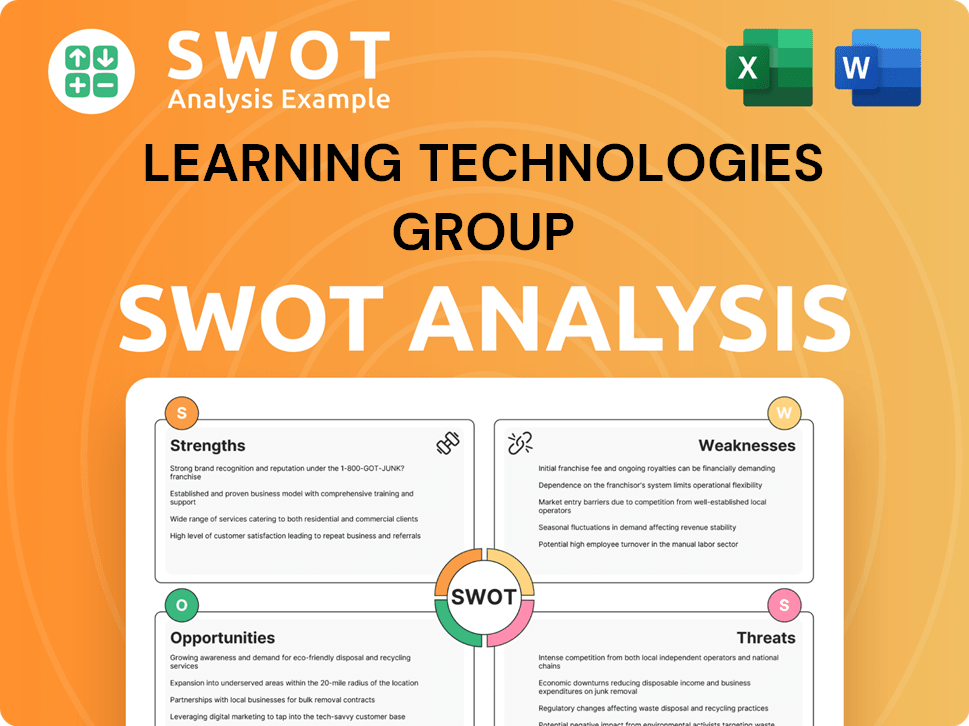
What Do Learning Technologies Group’s Customers Want?
Understanding the customer needs and preferences is crucial for any company, and for Learning Technologies Group (LTG), this involves a deep dive into the motivations and behaviors of its clients. The primary goal is to enhance organizational performance through effective learning and talent management solutions. This focus shapes the needs, preferences, and purchasing decisions of its customers.
The target market for LTG is diverse, encompassing various industries and organizational sizes, all united by a common need: to improve employee skills, ensure compliance, and foster a culture of continuous learning. The company's success hinges on its ability to provide solutions that address these critical needs, driving customer loyalty and business growth.
LTG's customers are driven by the need to solve specific pain points within their organizations. These include inefficient onboarding processes, the lack of engaging compliance training, difficulties in upskilling their workforce, and challenges in identifying and nurturing future leaders. LTG’s offerings are designed to directly address these issues, providing measurable improvements in employee engagement, reduced training costs, and enhanced regulatory compliance.
Customers seek solutions that can grow with their organizations, accommodating increasing numbers of users and expanding training needs. Scalability is a key factor in their purchasing decisions.
Seamless integration with existing HR systems is a must. This ensures that learning solutions fit smoothly into the existing infrastructure, improving efficiency.
Easy-to-use platforms are essential for ensuring high adoption rates and maximizing the impact of training programs. User experience is a priority.
Customers value access to a wide range of training content, covering diverse topics and skill sets. This breadth of content supports various learning needs.
Clients want to see a clear return on investment from their learning initiatives. Measurable results are crucial for justifying the investment.
A key outcome customers seek is increased employee engagement. Effective learning programs contribute to a more motivated and productive workforce.
The customer base of LTG is diverse, with varying product usage patterns depending on specific needs. Some customers prioritize learning platforms for broad employee training, while others focus on custom content development for specialized skills or strategic consulting for talent transformation. LTG's solutions are designed to be adaptable, addressing common pain points with a unified suite that can be tailored to specific organizational requirements. For example, LTG's solutions help organizations streamline their onboarding processes, potentially reducing the time to productivity for new hires by up to 30%, according to industry reports. The company stays responsive to market trends, such as the increasing demand for AI-powered learning and personalized learning paths, to enhance its products and services. The company tailors its marketing messages by highlighting case studies and success stories relevant to specific industries or organizational challenges, demonstrating tangible benefits to similar clients. For a deeper dive into LTG's strategic approach, consider reading about the Growth Strategy of Learning Technologies Group.
LTG's customer base is driven by the need to improve employee skills, ensure compliance, and foster a culture of continuous learning. These needs are addressed through a variety of solutions.
- Upskilling and Reskilling: Providing training programs that help employees acquire new skills or adapt to changing job roles. In 2024, the demand for upskilling programs increased by 25% across various industries.
- Compliance Training: Ensuring that employees meet regulatory requirements through effective and engaging training modules. The market for compliance training is expected to reach $10 billion by 2026.
- Leadership Development: Offering programs that identify and nurture future leaders within organizations. Leadership development programs have shown to improve employee retention by up to 20%.
- Performance Support: Providing tools and resources that help employees perform their jobs more effectively in real-time. The use of performance support tools has increased by 40% in the past two years.
Learning Technologies Group PESTLE Analysis
- Covers All 6 PESTLE Categories
- No Research Needed – Save Hours of Work
- Built by Experts, Trusted by Consultants
- Instant Download, Ready to Use
- 100% Editable, Fully Customizable
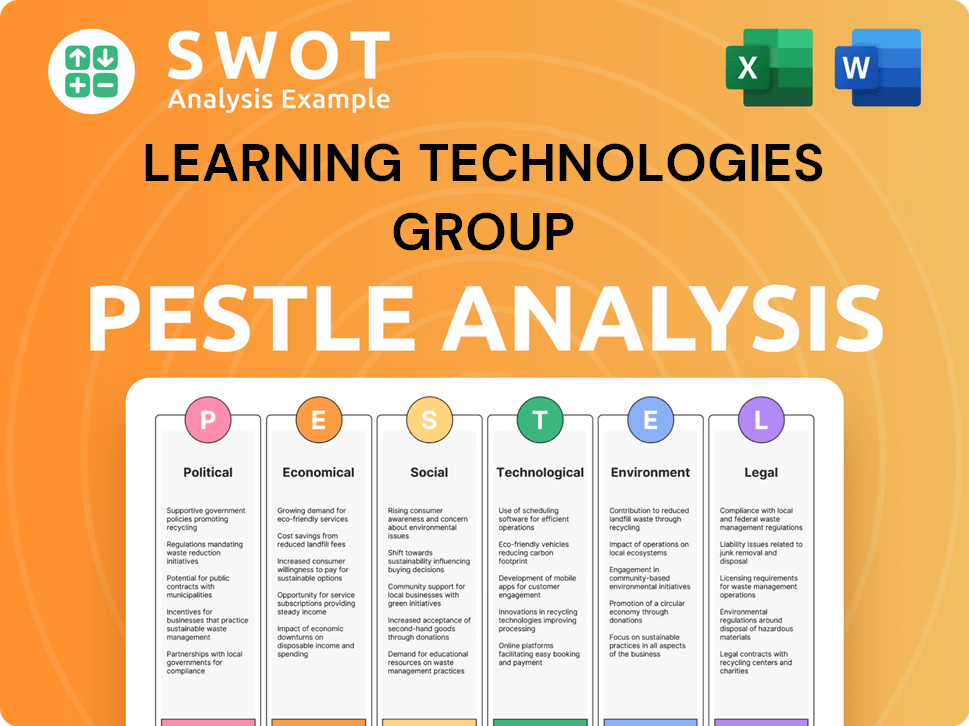
Where does Learning Technologies Group operate?
The geographical market presence of Learning Technologies Group (LTG) is substantial, with major operations and a significant client base spanning North America, Europe, and the Asia-Pacific region. The United States and the United Kingdom stand out as particularly strong markets for LTG, where the company holds considerable market share and brand recognition within the digital learning and talent management sectors. This is evident through its numerous client partnerships and the physical presence of its constituent brands in these regions. Understanding the nuances of customer demographics and preferences across these regions is crucial for LTG's strategic approach.
LTG's approach to these diverse markets involves tailoring its offerings to meet specific regional needs. For instance, compliance training content is often adapted to align with local regulations, and marketing messages are crafted to resonate with the local business cultures and priorities. This localized strategy is facilitated by the company's decentralized structure, which includes various acquired companies with established regional expertise and client relationships. This enables a deeper understanding of local market requirements and the ability to customize solutions effectively.
The company's strategic expansions and any strategic withdrawals are typically driven by market opportunities and the strategic alignment of potential acquisitions. The geographic distribution of sales and growth reflects the varying levels of digital learning adoption across different regions, with North America and Europe usually contributing the largest revenue shares. For a deeper dive into the company's ownership structure, consider reading Owners & Shareholders of Learning Technologies Group.
The North American market is a significant revenue contributor for LTG. The United States, in particular, represents a key market, with a high adoption rate of digital learning solutions. LTG's focus here includes tailoring content and services to meet the specific needs of US-based businesses and organizations.
Europe is another major market for LTG, with the United Kingdom being a particularly strong area. The company adapts its offerings to align with the varied regulatory environments and business cultures across European countries. This includes providing localized content and support.
LTG also has a growing presence in the Asia-Pacific region, where it is expanding its reach. The company focuses on understanding and catering to the distinct market dynamics within this diverse area. This includes adapting its solutions to meet the specific requirements of various countries within the region.
LTG employs localized strategies to cater to the diverse needs of its global customer base. This includes adapting content, marketing messages, and support services to align with regional regulations and cultural preferences. This approach ensures that LTG's solutions are relevant and effective in each market.
LTG's growth strategy involves strategic acquisitions to expand its geographical footprint and deepen market penetration. These acquisitions often bring regional expertise and established client relationships, enabling LTG to offer more tailored solutions. Recent expansions are driven by market opportunities and strategic alignment.
The geographic distribution of sales and growth reflects the maturity of digital learning adoption in different regions. North America and Europe typically represent the largest revenue contributors due to their advanced adoption rates. LTG continually monitors and adapts to these evolving market dynamics.
Learning Technologies Group Business Model Canvas
- Complete 9-Block Business Model Canvas
- Effortlessly Communicate Your Business Strategy
- Investor-Ready BMC Format
- 100% Editable and Customizable
- Clear and Structured Layout
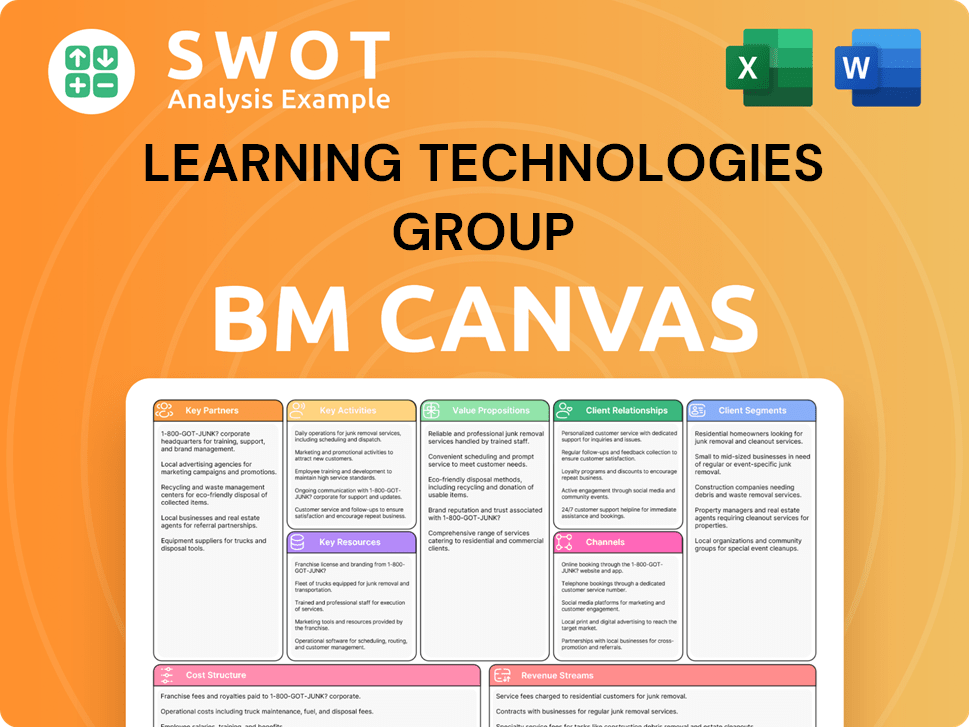
How Does Learning Technologies Group Win & Keep Customers?
Customer acquisition and retention strategies are vital for the success of Learning Technologies Group (LTG). The company employs a multi-faceted approach, blending digital and traditional marketing with strategic sales tactics. This comprehensive strategy is crucial for acquiring new clients and maintaining strong relationships, especially considering the recurring revenue model common in software and service contracts.
LTG's success hinges on its ability to attract and retain customers within the competitive education technology sector. This involves a deep understanding of its target market and the ability to adapt strategies to meet evolving customer needs. By focusing on integrated solutions and demonstrating clear ROI, LTG aims to increase customer lifetime value and establish itself as a strategic partner for talent development.
The company's approach is designed to resonate with its target audience, ensuring that its offerings are well-received and that customer relationships are nurtured. The strategies employed are continuously refined to maintain a competitive edge and provide maximum value to clients. For more insights into the company, you can also read the Brief History of Learning Technologies Group.
LTG utilizes content marketing, including whitepapers and webinars, to attract potential customers. Participation in industry conferences and trade shows is also a key acquisition strategy. Targeted digital advertising on platforms like LinkedIn is another important channel.
A consultative sales approach is central to LTG's strategy. Teams work closely with clients to understand their specific challenges. LTG demonstrates how its integrated offerings provide effective solutions tailored to each client's needs.
Dedicated account management and proactive customer support are key to customer retention. Regular product updates and enhancements are also crucial. LTG fosters strong client relationships through ongoing engagement.
Customer data and CRM systems are vital for segmenting clients and personalizing communications. This helps identify opportunities for upselling and cross-selling. Understanding a client's existing technology stack helps recommend compatible solutions.
LTG's focus is on providing integrated solutions to increase customer lifetime value. The goal is to become a strategic partner for long-term talent development needs. Successful campaigns highlight ROI through case studies and testimonials.
- Demonstrating ROI through case studies and testimonials.
- Offering integrated solutions to increase customer lifetime value.
- Becoming a strategic partner for organizations' talent development.
- Prioritizing continuous value delivery and high customer satisfaction.
Learning Technologies Group Porter's Five Forces Analysis
- Covers All 5 Competitive Forces in Detail
- Structured for Consultants, Students, and Founders
- 100% Editable in Microsoft Word & Excel
- Instant Digital Download – Use Immediately
- Compatible with Mac & PC – Fully Unlocked
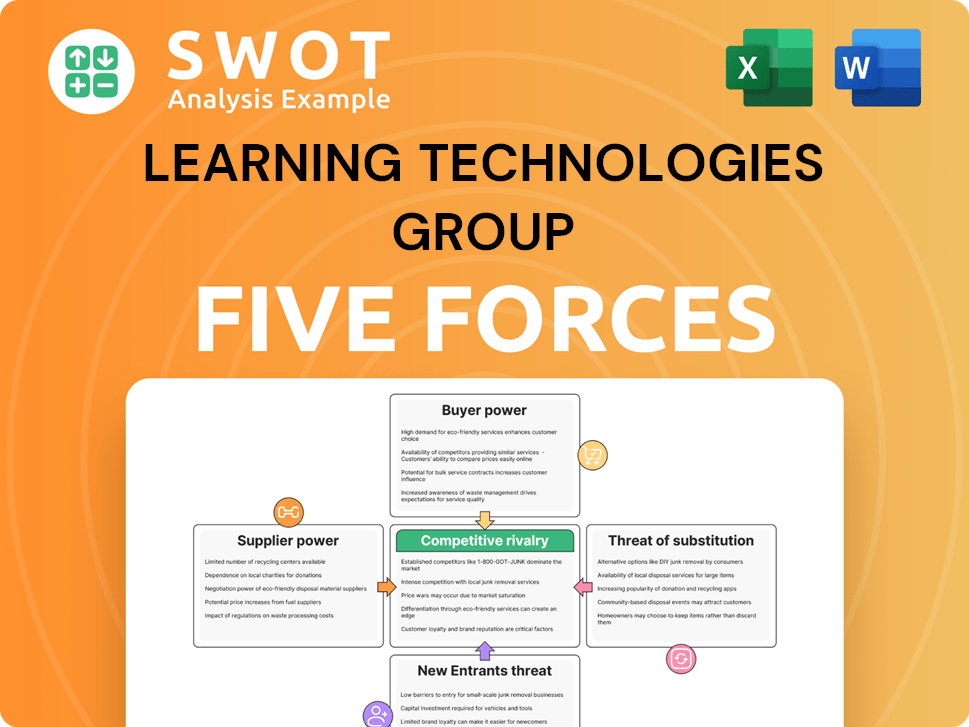
Related Blogs
- What are Mission Vision & Core Values of Learning Technologies Group Company?
- What is Competitive Landscape of Learning Technologies Group Company?
- What is Growth Strategy and Future Prospects of Learning Technologies Group Company?
- How Does Learning Technologies Group Company Work?
- What is Sales and Marketing Strategy of Learning Technologies Group Company?
- What is Brief History of Learning Technologies Group Company?
- Who Owns Learning Technologies Group Company?
Disclaimer
All information, articles, and product details provided on this website are for general informational and educational purposes only. We do not claim any ownership over, nor do we intend to infringe upon, any trademarks, copyrights, logos, brand names, or other intellectual property mentioned or depicted on this site. Such intellectual property remains the property of its respective owners, and any references here are made solely for identification or informational purposes, without implying any affiliation, endorsement, or partnership.
We make no representations or warranties, express or implied, regarding the accuracy, completeness, or suitability of any content or products presented. Nothing on this website should be construed as legal, tax, investment, financial, medical, or other professional advice. In addition, no part of this site—including articles or product references—constitutes a solicitation, recommendation, endorsement, advertisement, or offer to buy or sell any securities, franchises, or other financial instruments, particularly in jurisdictions where such activity would be unlawful.
All content is of a general nature and may not address the specific circumstances of any individual or entity. It is not a substitute for professional advice or services. Any actions you take based on the information provided here are strictly at your own risk. You accept full responsibility for any decisions or outcomes arising from your use of this website and agree to release us from any liability in connection with your use of, or reliance upon, the content or products found herein.